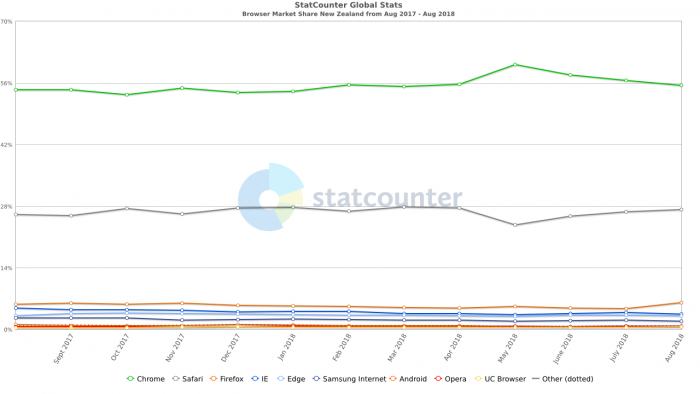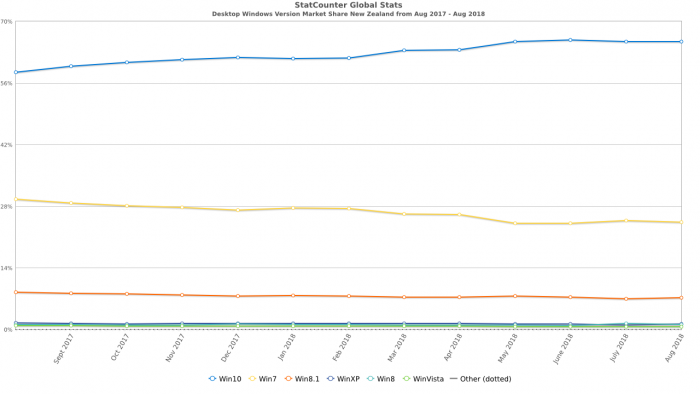BLOG
Web Browser Compatibility Update 2018
Back in January 2016 we wrote a post on Why Web Browser Compatibility is Important to Us and then in September 2017 we provided an update on the browsers that we supported in our testing regime. As people update the operating systems on their computers and devices, the browsers associated with them are also updated. Market share of particular operating systems and, therefore the browsers that people use to surf the web, is constantly changing so we thought it was again time to write an updated post outlining the latest stats.
Testing and quality control form an integral part of our design and development lifecycle and we pride ourselves on how robust our process is and how it differentiates us from other web development companies. Our goal is to deliver a quality website that you can depend upon. We adhere to the latest web standards to ensure that your website will work on a variety of browsers and devices now and in the future when new technologies are released. Before any or our websites are launched, they are rigorously tested using best practice testing tools and procedures. Over the years we have refined our quality control process to ensure consistent results and performance.
Along with full testing by the Developer and independent testing by our Lead Developer through the development phase, an independent QA Controller also conducts a meticulous 50-point testing and review process at the completion of the website development phase and immediately prior to launch. This includes exhaustive testing for cross browser consistency, cross device testing, page speed testing, HTML and CSS validation, as well as a full functionality and layout check.
Microsoft’s most current browser is Edge which was released with Windows 10 and until recently we had continued to test in Internet Explorer 11 (IE11) - the latest version of the Microsoft browser prior to Edge. However, we have now made the decision to drop support for this problematic browser. Due to the difficulties that developers face when making websites compatible with IE, many companies breathed a sigh of relief when Microsoft released Windows 10 (and Edge) and they subsequently dropped support for IE11 immediately. We had continued to support IE11 due to its market share - there are still a lot of people (mostly companies) around the world using Windows 7 - but, that said, as IT departments begin to upgrade to Windows 10 we expect Edge to eat up most of the market share or potentially lose it to Chrome.
Aside from Microsoft browsers we also build for and test in Chrome, Firefox and Safari. These browsers together claim more than 70% global market share and differ in the fact that they are not released as versions with operating systems as such but rather browser updates are automatically ‘pushed out’ to you each time you close/open your browser (dependant on your browser settings).
It’s important to point out that every browser and every version of that browser is idiosyncratic. Our web developers are skilled at identifying those idiosyncrasies and tweaking websites accordingly. This ensures that your website displays consistently, regardless of browser.
Here is a little bit of background about each of the major browsers:
Internet Explorer (IE) and Edge
Developed by Microsoft and included as part of the Microsoft Windows line of OS. Won the first ‘browser war’ against Netscape Navigator which was the dominant browser in the 1990’s. A few of you may remember Netscape from the ol’ days… Here are the version releases and dates:
IE1 to E7: 1995 – 2009
IE8: 2009 – 2011
IE9: 2011 – 2012
IE10: 2012-2013
IE11: 2013 – present but waning
Edge: 2015 - present
Chrome
Developed by Google and publicly released in 2008. Chrome runs on Android (Google mobile OS), Windows (Microsoft), and iOS (Apple) operating systems.
Firefox
Developed by the Mozilla community and released in 2002. Mozilla was originally owned by the aforementioned Netscape, which lost the browser war to IE in the mid 90’s. Firefox has continued to maintain market share and runs on Windows, OS X (Apple), Android and Firefox OS (mobile).
Safari
Developed by Apple and first released in 2003. It is the default device on Apple Devices. A Windows version was available from 2007 – 2012 but was discontinued.
Here is the list of browsers that we currently build for and test in and the common operating system that supports them:
|
Browser |
Operating System (OS) |
|
Chrome |
Android, Windows, iOS |
|
Safari |
iOS |
|
Edge |
Windows 10 |
|
Firefox |
Windows, OS X, Android, Firefox |
|
Samsung Internet |
Android |
And here are some 2017/18 statistics that support our decision to no longer support IE11:
One year ago, IE was sitting at 4.88% share with a drop to 3.5% in August 2018. In contrast Edge, has remained relatively steady and is now sitting at 3.05%. Chrome and Safari continue to have dominant market share in NZ.

Source: http://gs.statcounter.com/browser-market-share/all/new-zealand
Windows 10 (which comes packaged with Edge) remains dominant while Windows 7 (IE11) has dropped from 29.54% a year ago to 24.39% with other Windows versions also losing market share.
 Source: http://gs.statcounter.com/windows-version-market-share/desktop/new-zealand
Source: http://gs.statcounter.com/windows-version-market-share/desktop/new-zealand
Back in 2015, Microsoft made an ‘end-of-life’ announcement for IE 8, 9 and 10 and stated that these browsers received their last security updates on 12th January 2016. Microsoft recommended that customers upgrade to the latest version of IE11 (due to still being supported on Windows 7, 8.1 and 10) but cautioned people on the risks of running older browsers whilst encouraging instead the download of the Edge browser. More info here: End of Support for Older Versions of Internet Explorer.
This post will hopefully give you some insight into the robust nature of our build and QC process and the lengths we go to to ensure your website displays consistently across all of the major browsers. You might like to also check out our post that talks about the range of devices we build for and test websites on – from desktop to tablet to mobile..
Disclaimer: Browser stats are notoriously difficult to obtain due to the way that different sources interpret the data and calculate the stats plus the popularity of browsers differs quite significantly by country. There are also biases when it comes to desktop vs. mobile data. I’ve offered my best efforts to give global statistics based on research from sitepont.com, gs.statcounter.com, netmarketshare.com and w3counter.com and this information is offered as a general insight into why we at Apex build for and test our websites in particular browsers. For further indepth information about how Browser Market share is calculated you might like to read these posts: How Browser Market Share is Calculated andNetMarketShare vs. StatCounter - Whose Online Measurements Can You Trust?









